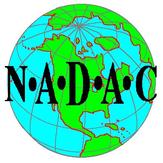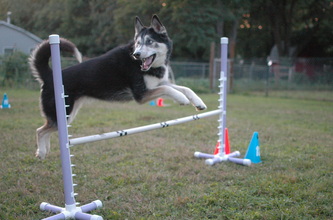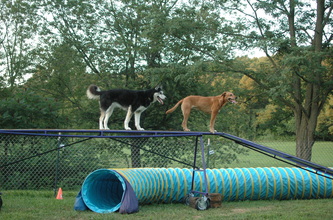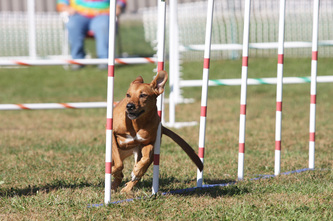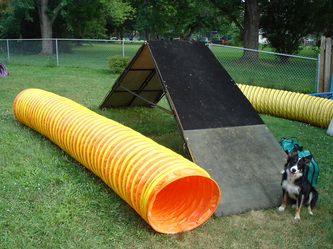Helpful Information About the
|
Mission
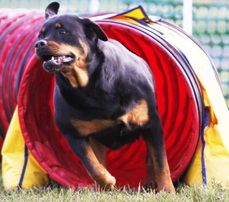
NADAC supports agility as a competitive sport, while striving to protect and advance the interests of dog agility by encouraging sportsmanlike competition and responsible dog ownership. We set forth and govern the guidelines that support the concept of fun, while maintaining a competitive and safe agility arena.
NADAC encourages and trains judges to set courses that are fast and flowing. Courses are traditionally fun and fast due to the flow and distance between obstacles. Our goal is to maintain an environment that tests dog and handler teams with appropriate challenges, while combining speed, accuracy, distance, and teamwork.
Purpose of Agility Trials
The purpose of a NADAC agility trial is to demonstrate the ability of the dog and its handler to work as a smooth functioning team. The dog should be under control at all times and show a willingness to work with the handler. Handlers should always conduct themselves in a sportsmanlike fashion.
NADAC encourages and trains judges to set courses that are fast and flowing. Courses are traditionally fun and fast due to the flow and distance between obstacles. Our goal is to maintain an environment that tests dog and handler teams with appropriate challenges, while combining speed, accuracy, distance, and teamwork.
Purpose of Agility Trials
The purpose of a NADAC agility trial is to demonstrate the ability of the dog and its handler to work as a smooth functioning team. The dog should be under control at all times and show a willingness to work with the handler. Handlers should always conduct themselves in a sportsmanlike fashion.
How to get your dog registered to compete in NADAC:
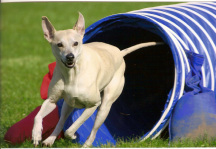
Online registration form: http://www.nadac.com/dogs.htm
All dogs must be registered to compete in NADAC sanctioned events. This is a one-time process and the number assigned is permanent. Any healthy, trained dog, purebred or mixed-breed, over eighteen (18) months of age is eligible to compete in NADAC trials.
Note: It is best to submit an on-line registration and receive a number immediately. A mailed in registrations will take a minimum of four weeks to process.
You do not need to wait until your dog is 18 months old to register. You can do so at any time prior to entering your first trial using our convenient online registration form.
All dogs must be registered to compete in NADAC sanctioned events. This is a one-time process and the number assigned is permanent. Any healthy, trained dog, purebred or mixed-breed, over eighteen (18) months of age is eligible to compete in NADAC trials.
Note: It is best to submit an on-line registration and receive a number immediately. A mailed in registrations will take a minimum of four weeks to process.
You do not need to wait until your dog is 18 months old to register. You can do so at any time prior to entering your first trial using our convenient online registration form.
Exhibitor's Handbook
Complete online Exhibitor's Handbook: http://www.nadac.com/rules.htm
Agility Obstacles
The following obstacles are allowed at NADAC agility trials:
Dog Walk, Weave poles, A-frame, Open tunnel, Non-winged jumps, Winged jumps, Hoops
(no teeter, no table, no tire, no chute)
Dog Walk, Weave poles, A-frame, Open tunnel, Non-winged jumps, Winged jumps, Hoops
(no teeter, no table, no tire, no chute)
Jump Height

Dogs entered in the Proficient Category must jump at the minimum jump height specified by the following table.
Dogs entering the Skilled Category MUST jump one jump height lower than the heights listed in the table, although no dog shall jump lower than 4”. All dogs must jump their valid jump height as determined by their Category and Division and may not jump higher.
As the table shows, there are five Standard Division-Proficient jump heights: 8”, 12”, 16”, 20”, 20+. There are four Standard Division-Skilled jump heights: 4”, 8”, 12”, and 16”. There are four jump heights for the Veterans and Junior Handler divisions: 4”, 8”, 12”, and 16”.
Veterans and Junior Handler dogs must jump their valid jump height and may not jump higher; thus, a Vets or JH dog may not jump higher than 16” in the Proficient category and no higher than 12” in the Skilled category.
There is no 4” Standard Division jump height in Proficient; the 4” Proficient height is for veteran dogs/handlers, disabled handlers, and junior handlers only. In the Skilled category, 8” dogs may jump 4” as their standard jump height. No dog may jump lower than 4”.
Jump Height Exemptions
Dogs listed on the Jump Height Exemption list are not required to be measured. Dogs in the following list of breeds may jump 4” lower than they would normally jump as determined by their measurement. The “breed exemption” jump height becomes their accepted Standard division jump height. For example, if a Corgi were to measure into the 12” jump height group, they are allowed to enter the 8” Standard division jump height group. However, the breed exemption may NOT be used to enter a dog at the 4” height unless they are entered in the Veterans or JH divisions or the Skilled category.
Am. Staffordshire Terrier, Cavalier King Charles Spaniel, Petite Basset Griffon Vendeen, Australian Terrier, Clumber Spaniel, Pug, Basset Hound, Dachshund, Scottish Terrier, Bulldog, French Bulldog, Staffordshire Bull Terrier, Bull Terrier, Glen of Imaal Terrier, Swedish Valhund, Cairn Terrier, Miniature Bull Terrier, West Highland White Terrier, Cardigan Welsh Corgi, Pembroke Welsh Corgi
Mixed breed and large/heavy boned dogs may apply for a height exemption. Requests are considered on an individual basis. Two pictures of the dog standing, front and side, as well as a letter of request with verification of height/weight are required when applying for a jump height exemption.
It is believed that, at all times, handlers will enter their dogs at the appropriate heights, using sound ethics and good sportsmanship. This height exception is for the health and well-being of the dog, not to give one dog a competitive edge over another dog. NADAC assumes that any handler who enters a dog at a lower height has done so to maintain the longevity and good health of their canine companion.
Levels, Divisions, Categories, and Classes
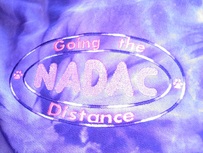
The four levels offered are Intro, Novice, Open, and Elite.
The three divisions offered are Standard, Veterans, and Junior Handlers.
The two categories offered are Skilled and Proficient.
The certification classes are Regular Agility, Jumpers, Tunnelers, Weavers,
Touch N Go, Chances, Gamblers, Barrelers and Hoopers.
The three divisions offered are Standard, Veterans, and Junior Handlers.
The two categories offered are Skilled and Proficient.
The certification classes are Regular Agility, Jumpers, Tunnelers, Weavers,
Touch N Go, Chances, Gamblers, Barrelers and Hoopers.
NADAC offers titling opportunities in the following classes:
Regular Agility Class
The Regular Agility class is a numbered course that may consist of all obstacles allowed on the NADAC equipment list.
- At the Novice level, the main goal is to test the dog's ability to perform the obstacles safely. The dog is asked to perform the obstacles at a moderate pace and at a moderate distance.
- At the Open level, the goal is to test the handler and dog's ability to perform the obstacles at a faster pace, while performing the obstacles with more directional and distance control and exhibit obstacle discrimination. The course design should encourage handlers to work the dog from both sides comfortably.
- At the Elite level, more complex handler strategies are tested, with the dog moving at a brisk pace. The dog should work off both sides of the handler, be able to discriminate between obstacles and freely move away from the handler while performing the obstacles with greater distance and directional control.
Jumpers Class
The Jumpers class is a numbered course that consists of jumps and 1-2 tunnels.
The goal of the Jumpers class is to demonstrate the ability of the handler and dog to work as a fast-moving, smooth functioning team.
Tunnelers Class
The Tunnelers class is a numbered course comprised of only tunnels.
The goal of the Tunnelers class is to demonstrate the dog’s ability to respond quickly to directional commands from the handler while negotiating a course comprised of only tunnels.
Weavers Class
The Weavers class is a numbered course comprised of tunnels, hoops, and weave poles.
The goal of the Weavers class is to demonstrate the dog’s ability to correctly enter weave poles at a variety of angles and at greater speeds than required in the Regular Agility class.
- At the Novice Level, dogs will be tested on three short sets of weave poles.
- At the Open Level, dogs will be tested on three sets of weave poles: one long set and two short set of poles.
- At the Elite Level, dogs will be tested on three sets of long weave poles.
Touch N Go Class
The Touch N Go class is a numbered course comprised of contact obstacles, tunnels and hoops.
The goal of the Touch N Go class is to demonstrate the dog’s ability to perform contact obstacles correctly on a course comprised of tunnels, hoops and contact obstacles. Typically, there shall be three to four contact performances in the class.
Chances Class
The Chances class is a numbered course that could have any of the acceptable obstacles listed in the NADAC equipment list.
The goal of the Chances class is to test the distance, directional and discrimination (DD&D) skills of the dog and handler team. The Chances course shall consist of a numbered sequence of 10-15 obstacles. In addition, the course shall include distance tests, discrimination tests, and directional tests. At each level the tests will include more difficult sequences as the dogs progress though the Novice, Open and Elite levels. - At the Elite level, distance tests shall be set at a minimum of 20 feet .
- At the Open level, distance tests shall be set at a minimum of 15 feet.
- At the Novice level, distance tests shall be set at aminimum of 10 feet.
There shall be no more than one performance of a set of weave poles during the course, and it is possible that there will be courses with no weave pole performances.
Barrelers Class
The Barrelers class is a special skills class that emphasizes handling via a numbered course comprised of barrels, hoops and tunnels.
The goal of the Barrelers class is to demonstrate the handler’s ability to direct their dog through a series of ground based obstacles – hoops, tunnels and barrels.
Hoopers Class
The Hoopers class is a course as designed by the handler to demonstrate the dog’s ability to follow directional tests upon the direction of the handler.
The goal of Hoopers is to demonstrate the team's ability to handle and communicate effectively while the dog runs through a course consisting entirely of hoops.
Regular Agility Class
The Regular Agility class is a numbered course that may consist of all obstacles allowed on the NADAC equipment list.
- At the Novice level, the main goal is to test the dog's ability to perform the obstacles safely. The dog is asked to perform the obstacles at a moderate pace and at a moderate distance.
- At the Open level, the goal is to test the handler and dog's ability to perform the obstacles at a faster pace, while performing the obstacles with more directional and distance control and exhibit obstacle discrimination. The course design should encourage handlers to work the dog from both sides comfortably.
- At the Elite level, more complex handler strategies are tested, with the dog moving at a brisk pace. The dog should work off both sides of the handler, be able to discriminate between obstacles and freely move away from the handler while performing the obstacles with greater distance and directional control.
Jumpers Class
The Jumpers class is a numbered course that consists of jumps and 1-2 tunnels.
The goal of the Jumpers class is to demonstrate the ability of the handler and dog to work as a fast-moving, smooth functioning team.
Tunnelers Class
The Tunnelers class is a numbered course comprised of only tunnels.
The goal of the Tunnelers class is to demonstrate the dog’s ability to respond quickly to directional commands from the handler while negotiating a course comprised of only tunnels.
Weavers Class
The Weavers class is a numbered course comprised of tunnels, hoops, and weave poles.
The goal of the Weavers class is to demonstrate the dog’s ability to correctly enter weave poles at a variety of angles and at greater speeds than required in the Regular Agility class.
- At the Novice Level, dogs will be tested on three short sets of weave poles.
- At the Open Level, dogs will be tested on three sets of weave poles: one long set and two short set of poles.
- At the Elite Level, dogs will be tested on three sets of long weave poles.
Touch N Go Class
The Touch N Go class is a numbered course comprised of contact obstacles, tunnels and hoops.
The goal of the Touch N Go class is to demonstrate the dog’s ability to perform contact obstacles correctly on a course comprised of tunnels, hoops and contact obstacles. Typically, there shall be three to four contact performances in the class.
Chances Class
The Chances class is a numbered course that could have any of the acceptable obstacles listed in the NADAC equipment list.
The goal of the Chances class is to test the distance, directional and discrimination (DD&D) skills of the dog and handler team. The Chances course shall consist of a numbered sequence of 10-15 obstacles. In addition, the course shall include distance tests, discrimination tests, and directional tests. At each level the tests will include more difficult sequences as the dogs progress though the Novice, Open and Elite levels. - At the Elite level, distance tests shall be set at a minimum of 20 feet .
- At the Open level, distance tests shall be set at a minimum of 15 feet.
- At the Novice level, distance tests shall be set at aminimum of 10 feet.
There shall be no more than one performance of a set of weave poles during the course, and it is possible that there will be courses with no weave pole performances.
Barrelers Class
The Barrelers class is a special skills class that emphasizes handling via a numbered course comprised of barrels, hoops and tunnels.
The goal of the Barrelers class is to demonstrate the handler’s ability to direct their dog through a series of ground based obstacles – hoops, tunnels and barrels.
Hoopers Class
The Hoopers class is a course as designed by the handler to demonstrate the dog’s ability to follow directional tests upon the direction of the handler.
The goal of Hoopers is to demonstrate the team's ability to handle and communicate effectively while the dog runs through a course consisting entirely of hoops.
NADAC's VT Program At a Glance:
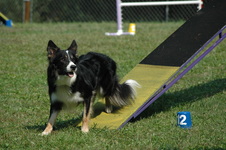
NADAC is now accepting videotaped agility runs!
We know of the many “backyard champions” and also people in remote areas who would love to have more NADAC trials available to them! Now you can trial as much as you want, as long as you can set a course and have a video person available that can do a good job of video taping your run!
You and your dog can earn VT titles in all NADAC classes, including Beginners Agility tests. Titles earned through the VT program will have a "VT" designation.
Runs must be taped start-to-finish. All NADAC rules apply. There is a $10 fee for submitting a video for review.
For more information, click here: http://nadac.com/VT-Video-Tape-Program.htm
We know of the many “backyard champions” and also people in remote areas who would love to have more NADAC trials available to them! Now you can trial as much as you want, as long as you can set a course and have a video person available that can do a good job of video taping your run!
You and your dog can earn VT titles in all NADAC classes, including Beginners Agility tests. Titles earned through the VT program will have a "VT" designation.
Runs must be taped start-to-finish. All NADAC rules apply. There is a $10 fee for submitting a video for review.
For more information, click here: http://nadac.com/VT-Video-Tape-Program.htm
